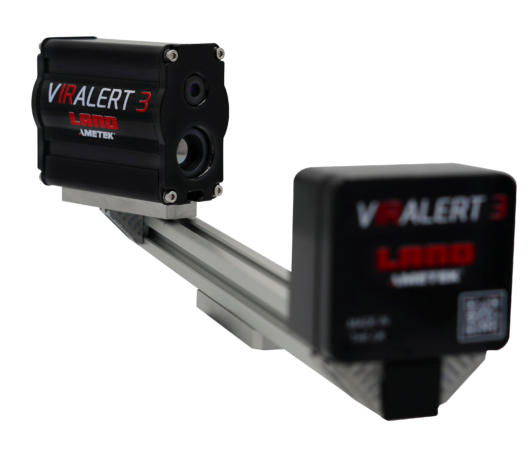
The benefits of infrared human body temperature screening as part of COVID-19 countermeasures
Don Horne
Features News ipptCOVID-19 is a major challenge for businesses that are reopening after lockdowns around the world. With no vaccine available for wide scale deployment in the near future, the ‘new normal’ could mean that localized outbreaks will continue to resurge, hampering the recovery of businesses and institutions that are reeling from a prolonged period of limited or no operation.
Many businesses are following government guidance to implement a range of measures designed to limit the spread of the virus. The core advice around social distancing, hand hygiene, and wearing of face coverings will continue to be important, but this isn’t always practical in many enclosed spaces and environments – such as offices, factories, shops, and leisure facilities – where the virus is more easily spread.
Equally, indefinite lockdowns and restrictions of movement, commerce and leisure are extremely damaging economically and socially. Therefore, finding suitable measures to mitigate the spread of the virus amongst staff, customers and visitors to commercial premises will help increase the resilience of the business and maximize its ability to remain open.
Social distancing, hand hygiene, and face masks all have their benefits and drawbacks, but using a combination of them will increase the resilience of a facility. This can be further enhanced by accurate and effective human body temperature screening at points of entry.
Temperature screening
Many governments recommend temperature screening as an additional precaution to the core countermeasures.
There are several different methods of human body temperature measurement, with varying levels of ease of use, accuracy, repeatability, and practicality.
Handheld non-contact thermometers offer varying accuracy – some have an accuracy range of more than ±2°C (±3.2°F), a margin of error which is likely to create a large number of false positive or false negative readings when trying to detect elevated temperatures.
A further drawback of this type of technology is that portable handheld devices require social distancing guidelines to be violated. The person carrying out the measurement will need to get within 1 metre (~3 ft) of the individual being measured. This could increase the infection risk to the person measuring, and therefore to everyone entering the facility.
It is possible to measure temperature accurately using non-contact Infrared thermometer and imagers. However, the amount of heat energy (in the form of infrared radiation) emitted by the human body is relatively small, which presents a challenge in making reliable measurements in non-ideal conditions.
Additionally, ideal conditions for this type of measurement would typically entail zero solar radiation or reflections (a dark room), constant ambient temperature, and a measurement time for each individual of several minutes, with the person kept in the same place during the measuring process.
To overcome these challenges, consideration needs to be given to the design of the system in order to give accurate and repeatable temperature measurement readings.
Using a blackbody heat source
Integrating a black body heat source within the screening system is a proven method for minimizing the effects of the surrounding environment.
This is a precision-engineered component that provides a reference heat source, to a very tight tolerance, that can be viewed in the same frame as the individual that is being measured.
If the distance of the black body and the person being measured are known, it is possible ‘calibrate’ the measurement in real time, in non-ideal conditions, using a feedback loop and algorithm in the associated software.
This means that a unit with an integrated black body at specified fixed distance removes potential errors in complicated software set-ups, where the black body is a separate unit that can be mounted in differing relative distances to the thermal imager due to the installation location.
Developing the VIRALERT 3
AMETEK Land has been involved in developing temperature measurement solutions to help combat virus outbreaks since the Sudden Acute Respiratory Syndrome (SARS) outbreak of 2003, and including Middle East Respiratory Syndrome (MERS), Swine Flu and Bird Flu.
 Like COVID-19, these are respiratory-type illnesses which typically present with an elevated temperature and fever.
Like COVID-19, these are respiratory-type illnesses which typically present with an elevated temperature and fever.
The company’s expertise in temperature measurement goes back even further, to 1947, and it is a trusted expert in the provision of accurate, repeatable temperature measurement instrumentation to industry.
The evolving development of AMETEK Land’s human body temperature screening has led to the launch of the new VIRALERT 3 thermal imaging system. This is a safe, accurate system that is easy to set up and use.
It uses a fixed, black body calibration source to ensure the measurements remain accurate to within ±0.5oC. This is integrated onto the same arm as the thermal imaging camera, so the system is highly compact.
Taking a non-intrusive image from a safe distance, VIRALERT 3 provides an instant, contactless reading of temperature without sacrificing social distancing standards, unlike handheld thermometers.
Because it takes only two seconds to scan each person passing through the entry point and return a result, there is a minimal impact on the flow of people.
Conclusion
Like the other core mitigation measures temperature screening is not infallible, as some of those infected with COVID-19 may be asymptomatic, and therefore not have an elevated body temperature to raise an alarm.
However, temperature screening if carried out with appropriate equipment offers an additional counter measure to enhance protection and limit the spread of coronavirus in office and manufacturing environments.
The more precautions that can be taken, the greater the resilience of the premises, ensuring that staff, suppliers, and customers will have more confidence in regularly using the facility.
Print this page